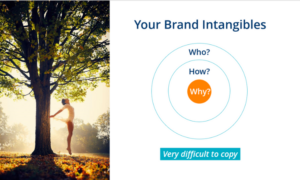
You’re a coach who wants to make a difference for your clients, so how do you differentiate your business? Answer: make your brand human and distinctive, and create authentic relationships
The benefits of making your brand human include:
As Scott Talgo sums up “A brand that captures your mind gains behaviour. A brand that captures your heart gains commitment.”
Creating the ‘who’ of your brand may not be on your radar, yet it’s one of the foundations of your marketing strategy and approach.
ChatGPT put ‘develop a strong brand identity’ 2nd in a list of 15 activities that could make your business attractive to clients. Here’s the list for reference:
The explanation for developing your strong brand identity is summarised as:
Both of which are excellent aims, so in this blog I’ll focus on brand identity.
You’ll notice that I say brand identity and not brand logo. This is because your brand identity comprises much more than your brand logo, whilst the role of your logo is to express your brand identity.
Here’s a definition of ‘brand’ from the Chartered Institute of Marketing:
“The best brands create a special relationship with customers, based on intangible qualities that evoke strong emotional responses.”
So, once you’re clear on your target clients, coaching focus and your value proposition (the reasons clients will prefer to buy from your business instead of another), you can begin crafting your brand identity which starts with your key brand intangibles.
I like to describe these intangibles as the:
The magic of these core brand intangibles is that your combination of why, how and who is very difficult to copy.

Why did you set up your business? You may have a personal ‘why’ aligned with your business purpose. Simon Sinek says people buy into why you do what you do, more than what you do.
So, your aim is to align your brand purpose and passions with your target client wants and needs (even if they don’t know it yet).
You could consider:
Your key question is what does your brand believe in?
Your brand values matter because they set the moral compass of your business and determine how your brand behaves with others – from clients and employees to suppliers and stakeholders. In a nutshell, your brand values shape the attitudes, behaviour and culture of your business.
And brand values matter because shared values attract like-minded clients. As Howard Schulz says “If people believe they share values with a company, they will stay loyal to the brand.”
When shaping your brand values, you could consider:
.
Having a distinctive brand personality – irrespective of your brand name and the number of people in the business – helps to develop your brand ‘know, like, trust’ factor.
It’s an essential component in creating affinity and emotional connections with your target clients.
“It’s about bringing who you are to what you do and how you do it.” Say PwC
When determining your brand personality you could imagine your brand is a person and consider:
I’ll give the last word to Walt Disney who understood about creating emotional connections “Until a character (your brand) becomes a personality it cannot be believed”.

Lynne Stainthorpe is a brand strategist who works with coaches, consultants and therapists to make your brand human, relevant and distinctive, so that your business stands out, grows affinity and creates impact. She is a LinkedIn Top Voice.
Lynne uses a proven process to develop your brand identity, personality and tone of voice, based on your brand vision and values. She gets to the heart and soul of your brand and brings it to life throughout your branding and marketing collateral. She helps position and package your services, and develop your value proposition, so that you can communicate your brand message effectively and consistently within a flexible framework.